5 Flowise Alternatives & Competitors for 2025
In the past few years, several tools have come to market, aiming to simplify and expedite the process of building AI agents.
Flowise is one of the most successful entrants into this space, offering a primarily visual experience for creating, deploying, and managing agentic systems. This includes low-code tools that enable us to drag and drop configurable elements to determine agent behavior.
This has helped to position Flowise as a popular option for developers and non-developers alike, as interest in agentic AI has exploded.
But this is a fast-moving space, and Flowise is not the only show in town. Today, we’re giving a broader account of the whole market by checking out the most prominent Flowise alternatives and competitors.
Along the way, we’ll cover a range of ground, including:
- What is Flowise?
- Who uses Flowise?
- Why would you need a Flowise alternative?
- 5 Flowise alternatives for 2025
Let’s jump right in.
What is Flowise?
Flowise is an open-source low-code platform for building AI agentic workflows . The goal is to empower teams with a drag-and-drop interfaces for creating LLM apps and AI agents, without extensive coding knowledge.
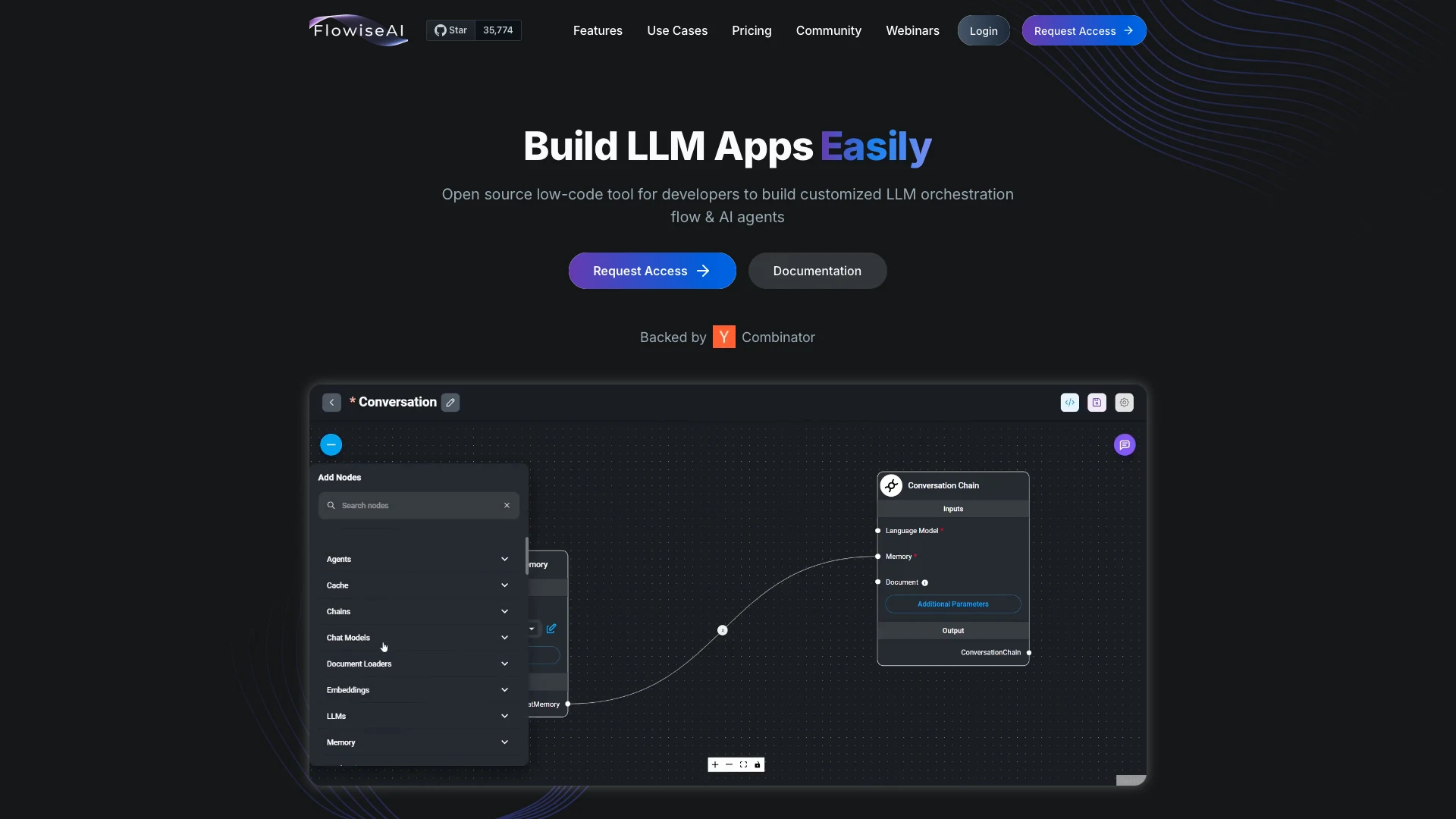
(Flowise Website)
It provides huge flexibility for creating a whole range of solutions, including chatbots, virtual assistants, automation solutions, data analysis tools, NLP apps, and more.
This works by providing modular, pre-built blocks that can be arranged, configured, and chained in order to build agents. By prioritizing reusability, Flowise greatly speeds up and simplifies the agent-building process.
There are three distinct builders within this, offering distinct levels of capabilities for systems of different complexity:
- Assistant - A beginner-friendly tool for building agents that can follow instructions, use tools, and perform RAG on uploaded files, without requiring custom code.
- Chatflow - A more flexible tool for building single-agent systems and LLM flows, with advanced techniques like Graph RAG, custom code modules, and more.
- Agentflow - A superset of Assistant and Chatflow, capable of outputting single-agent systems, multi-agent systems, workflow orchestration, and other more advanced use cases.
Besides building agents, Flowise offers important functionality for managing and maintaining them in production environments. This includes tracing and analytics tools for overseeing agent behavior.
As an open-source platform, it’s also highly flexible and extensible. For instance, there are extensive integration, database, and hosting options available, making it highly suited to enterprise environments.
Who uses Flowise?
As we’ve hinted at, Flowise provides tools for a range of different user personas, from largely no-code interfaces, to more in-depth, flexible tools that are suitable for developers and other technical colleagues.
To reflect this, Flowise is available as both a cloud-based service and a self-hosted solution.
So, with Flowise Assistant we don’t necessarily need extensive technical skills, enabling colleagues within business-level teams to create simple solutions targeting their team’s workflows.
However, some awareness of development topics is still helpful. This includes a basic understanding of prompt engineering for instructing models, as well as the basics of data structures and API usage for tool calling .
Flowise is also highly popular with enterprise IT teams, including several Fortune 500 companies.
This should perhaps be unsurprising, given that it’s highly suited to usage in complex production environments, including features such as self-hosting, traceability, and analytics that we discussed already.
As such, Flowise’s value-add in large organizations is enabling developers to simplify the process of building agentic systems, without compromising on other factors such as governance and security.
Why would you need a Flowise alternative?
But, as we said earlier, Flowise is not the only player in this space. Indeed, this is a fast-evolving market, with fierce competition between vendors. As such, it’s vital to have a clear picture of the key decision-points that will go into picking a platform for our specific requirements.
As with any software procurement decision, there is no AI agent builder that’s singularly better than the others in all cases. Rather, the key is understanding the core factors that will make certain platforms more suitable than others in individual situations.
One, naturally, is pricing. Flowise offers a usable free tier, alongside a generally affordable and scalable pricing model. But we may nonetheless find that alternative options are more cost-effective for specific use cases.
Similarly, although Flowise is a strong pick for a range of user personas, other platforms might be better optimized for individual types of colleagues and use cases.
For instance, developers might prefer more code-centric approaches to agent-building for advanced use cases. Or, if we’re targeting a very specific function with agentic systems, there are situations where we could be better served by a more domain-specific platform.
Lastly, we need to be cognizant of our wider IT environment when selecting agent platforms. Flowise can be connected to external tools using HTTP requests via LangChain or Zapier.
However, we might find that other platforms offer more extensive native integrations with enterprise tooling.
As ever, none of these are necessarily deal-breakers. Rather, they’re important considerations to keep in mind when comparing Flowise to its competitors.
5 Flowise alternatives for 2025
Now that we have a strong grasp of what Flowise is, what it does, and who uses it, we can start to check out some of the alternative platforms that are available on the market today.
As we said earlier, this is a fast-moving space. Indeed, over the past few years, software vendors in just about every niche have begun adding agentic AI capabilities to their core products.
We’ve chosen a diverse range of platforms to reflect this, while also focusing on some of Flowise’s more direct competitors.
Our picks are:
As we’ve said already, the goal isn’t to pick out specific tools that are generally better than others. Rather, it’s to highlight some of the most prominent options in this space, and the scenarios and use cases they’re best suited to.
Let’s check each one out in turn.
1. Moveworks
First up, we have Moveworks. Aimed largely at ITSM and other internal service functions, this is one of the biggest names in the AI agent space.
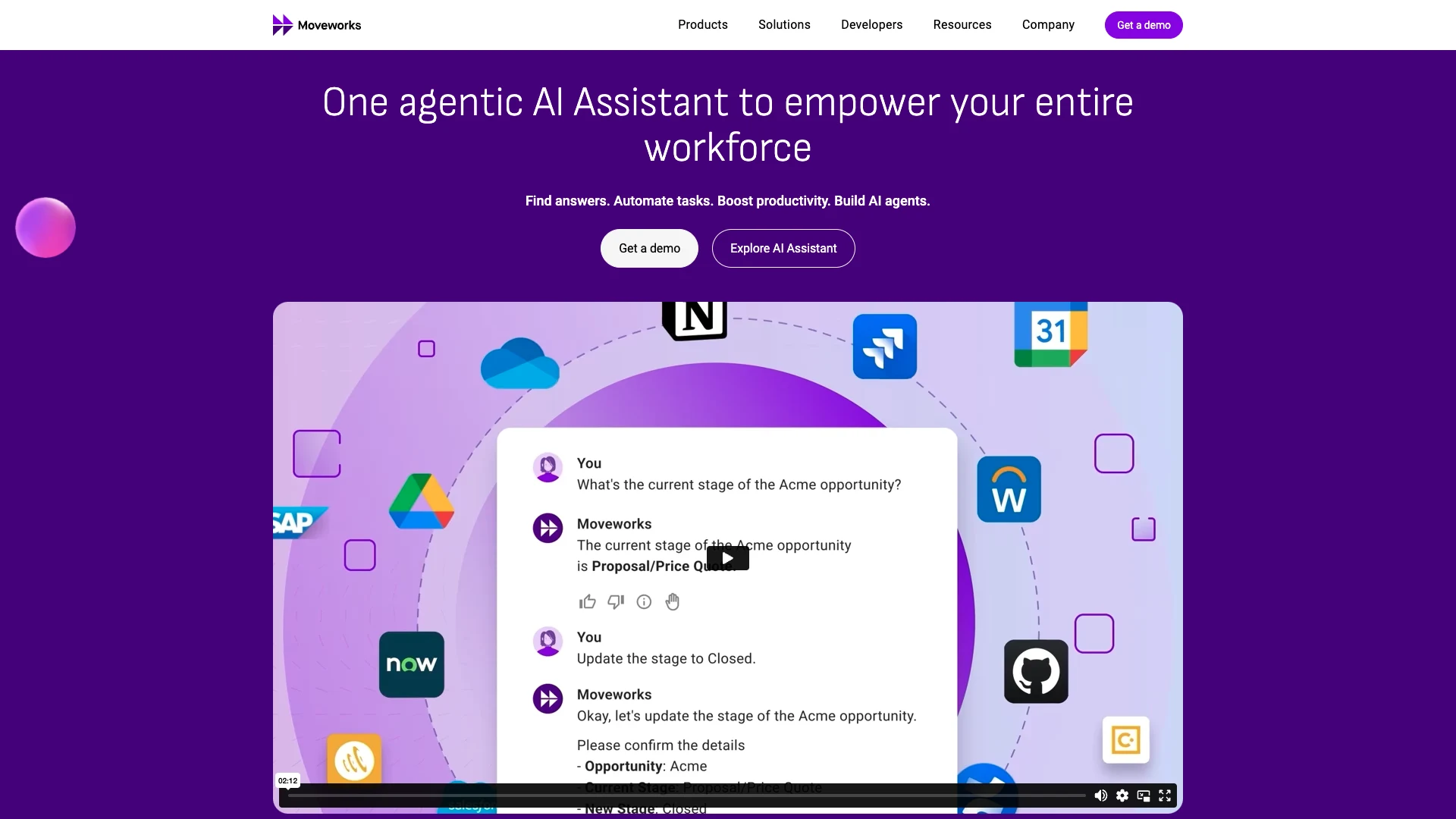
(Moveworks Website)
Pros
Moveworks is billed as a platform for building agentic agents to power the entire workforce. The goal is to expedite the process of building enterprise chatbots that can reason and act autonomously by providing reusable components and capabilities in an intuitive UX.
It’s also a highly extensible platform. Moveworks’ architecture emphasises plug-ins, with a huge range of tools available for various enterprise platforms, use cases, and specific actions, alongside a rich library of prebuilt agent templates.
Another area where Moveworks is particularly strong is advanced RAG use cases and enterprise search. With a combination of extensive data connectivity and advanced permissions and access controls, it’s a great option for putting information in the hands of colleagues who need it.
Cons
However, there are also potential downsides to Moveworks. One of the most obvious is that, as a platform aimed largely at service workflows within large enterprises, teams in smaller organizations or with more straightforward workflow automation needs might find other tools more suitable.
Some users also report that Moveworks presents a relatively steep learning curve, particularly when dealing with more complex use cases or less common integrations.
Moveworks is a closed-source platform. So, if open-source technologies are a priority in your organization, you might want to consider one of the open-source Flowise alternatives in our round-up.
Pricing
Moveworks’ pricing is not publicly disclosed. Instead, we’ll have to reach out for a quote for custom enterprise pricing.
According to official information, scalable pricing options are available, based on the specific needs, use-cases, and scale of individual customers.
However, according to some reports, this may skew towards the premium end of the market, especially compared to more transparent, tiered models from other vendors.
2. Zapier
Next up, we have Zapier. This is a household name in the world of workflow automation. As with many platforms, though, in recent years it’s moved squarely into the AI agent-building space.
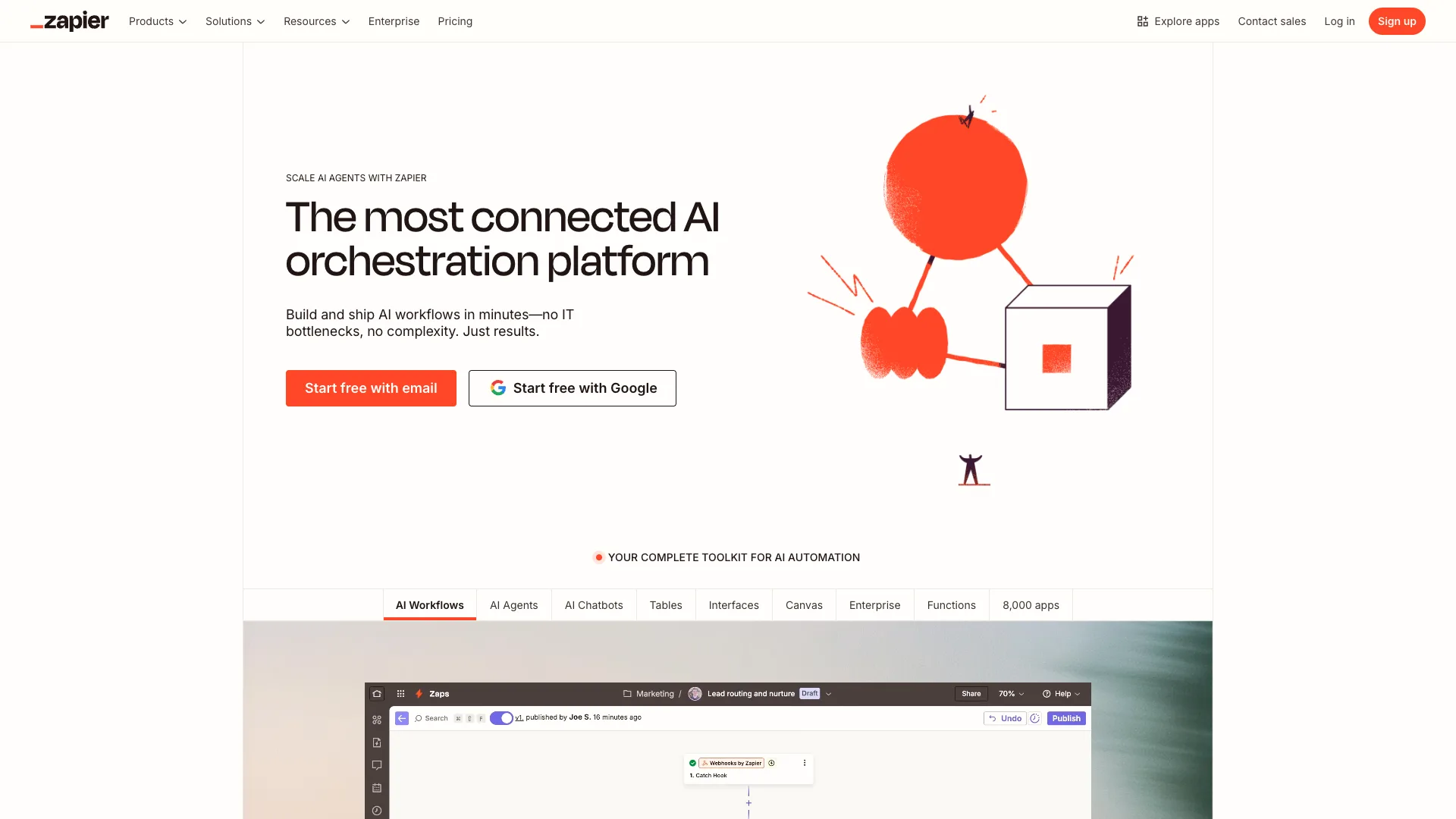
(Zapier Website)
Pros
Zapier is well-renowned for offering intuitive, visual experiences for configuring automation rules across multiple connected platforms. It offers a highly expedient, effective solution for teams that want to set up complex integration rules and logic.
It offers capabilities both for adding LLM-powered actions within workflow automations and building agentic systems. The latter combines speed and flexibility by enabling us to define behavior in natural language, before outputting step-based rules.
As such, Zapier is a particularly strong offering for empowering teams to output agents and other AI solutions, without requiring extensive technical knowledge or custom development work.
Cons
One thing that’s worth noting is that Zapier, while highly capable, wasn’t built from the ground up as an AI agent platform, in the way that some other Flowise alternatives were. So, it may be less optimized for certain advanced use cases, like Flowise’s ESM assistants.
Some other platforms are also more granularly aimed at developers and technical teams, providing more flexibility to manage aspects of our agentic systems via code that we see in Zapier.
Lastly, Zapier can’t be self-hosted, so we’ll need to look elsewhere if hosting on our own infrastructure is a firm requirement.
Pricing
One of the big reasons for Zapier’s lasting popularity is its generous, scalable pricing model. This model is largely usage-based, but some features are restricted across tiers, while others are available as optional add-ons.
There’s a usable free tier that will allow us to execute up to 100 tasks per month. Paid licenses start from $19.99 per month, on a sliding scale for each tier, based on the required number of tasks.
We’ll need custom enterprise pricing for advanced access control or observability features, while access to the full complement of chatbot capabilities is billed as an optional add-on from $13.33 per month.
You might also like our guide to digital workers .
3. n8n
Like Zapier, n8n is another long-standing workflow automation platform that has evolved to offer more AI-focused capabilities over the past few years. However, it’s also aimed at somewhat more technical teams, compared to Zapier’s broader user personas.
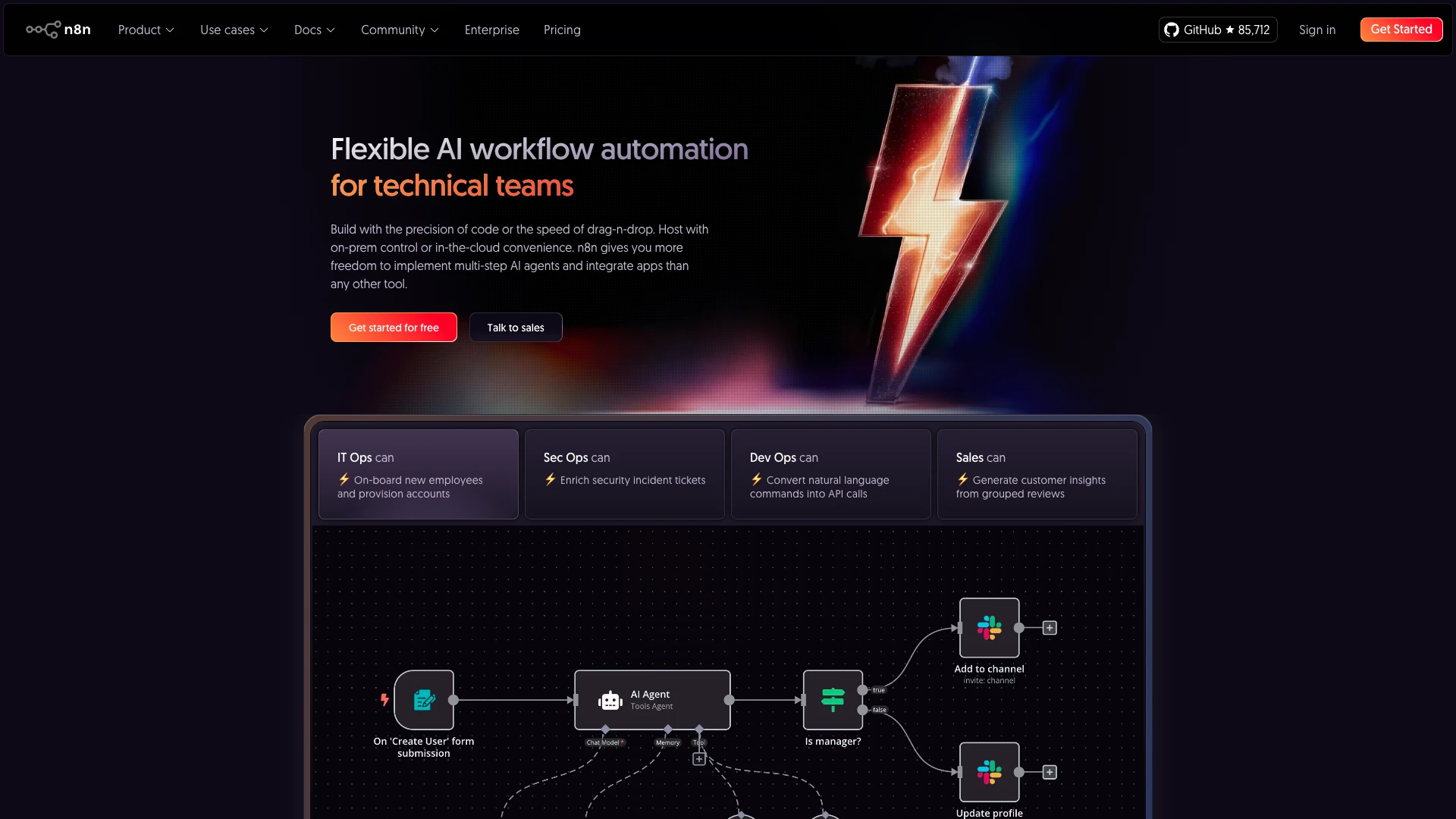
(n8n Website)
Pros
One massive upside to n8n is that it’s open-source. For many teams, this is a top priority, offering the ability to audit the source code of tools that interact with critical data, processes, and platforms.
It offers a highly intuitive, drag-and-drop experience for developing agents from reusable components, along with extensive scope for custom scripting. There’s also support for a huge range of models, memory stores, third-party tools, and more.
On top of this, n8n is well-optimized for enterprise usage, with debugging tools, Git-based version control support, secrets management, on-prem deployments, and other advanced security tools.
Cons
Like Zapier, it’s worth noting that n8n was not purpose-built as an AI agent platform. So, we may find that certain more advanced features, including memory handling or multi-agent orchestration, are better served in other tools.
It may be less well-suited to certain use cases too, as it doesn’t feature a native interface builder. Instead, we’ll have to rely on external solutions.
Some users complain that n8n’s visual builder can become somewhat cluttered when dealing with complex agent use cases, although we can avoid this by following best practices, including modularizing solutions.
Pricing
Like Zapier, n8n follows a transparent, usage-based pricing model. This has the potential to be highly affordable and scalable for many different kinds of teams.
Paid plans start from $24 for 2,500 executions per month. Increased usage limits plus advanced features such as workflow histories, global variables, and execution search are available on the Pro license.
A custom enterprise license will be needed for advanced features, such as SSO, Git-based version control, or extended data retention.
4. Aisera
Aisera is an AI agent platform that aims to automate all kinds of internal processes, making it one of Flowise’s most direct competitors.
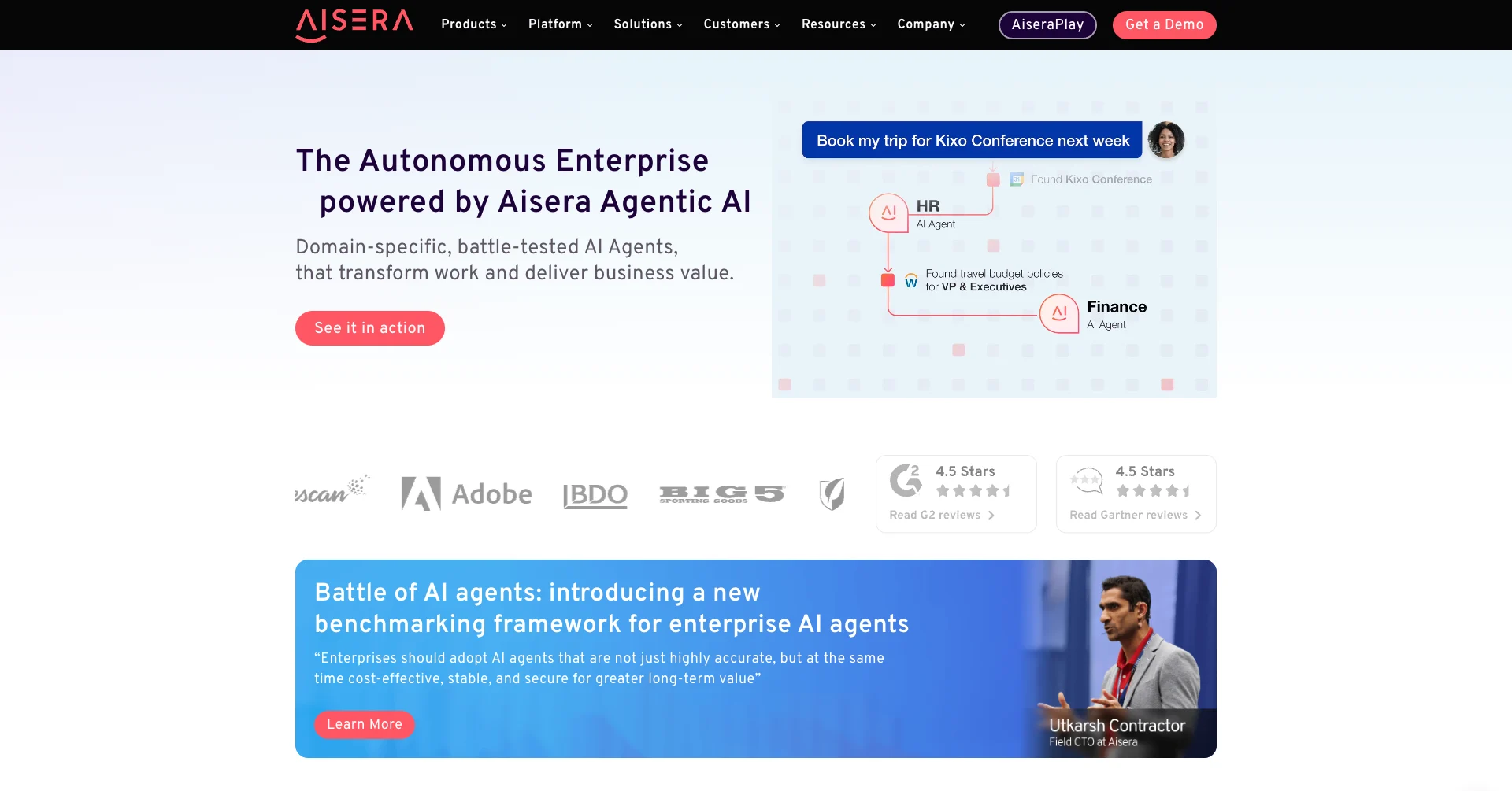
(Aisera Website)
Pros
A huge selling point of Aisera is enabling us to provide internal users with a unified experience for accessing services across the enterprise, with custom CoPilots to autonomously reason, perform enterprise search, provide answers, and take actions across our IT environment.
This centers around a range of tools for creating agentic solutions with rich automation logic, while minimizing development overheads. This includes a huge range of LLM integrations, pre-built flows, and a low/no-code interface for developing agents.
One standout feature is Aisera’s Universal Orchestration for AI agents. This allows us to deploy specialized agents for individual domains, which can be accessed through a unified interface for all end-user requests.
Cons
However, there are also some important potential drawbacks to Aisera. It’s important to emphasise that it’s largely targeted at large enterprises. As such, it offers a rich set of integration options, but these skew somewhat towards tooling for large organizations.
Some users also complain that Aisera can present a relatively high learning curve, including requiring additional support and guidance during initial configuration.
Like many other tools in this space, Aisera is a closed-source solution. Again, we may want to look elsewhere if open-source AI agents are a priority.
Pricing
Aisera does not publicly advertise pricing.
Instead, licenses are offered on a custom basis.
We’ll need to contact their sales team for a quote, with costs calculated on the requirements of individual customers.
5. OpenDialog
Lastly, we have OpenDialog. This is a no-code option aimed at teams that want to build AI agents that are strong on safety and transparency.
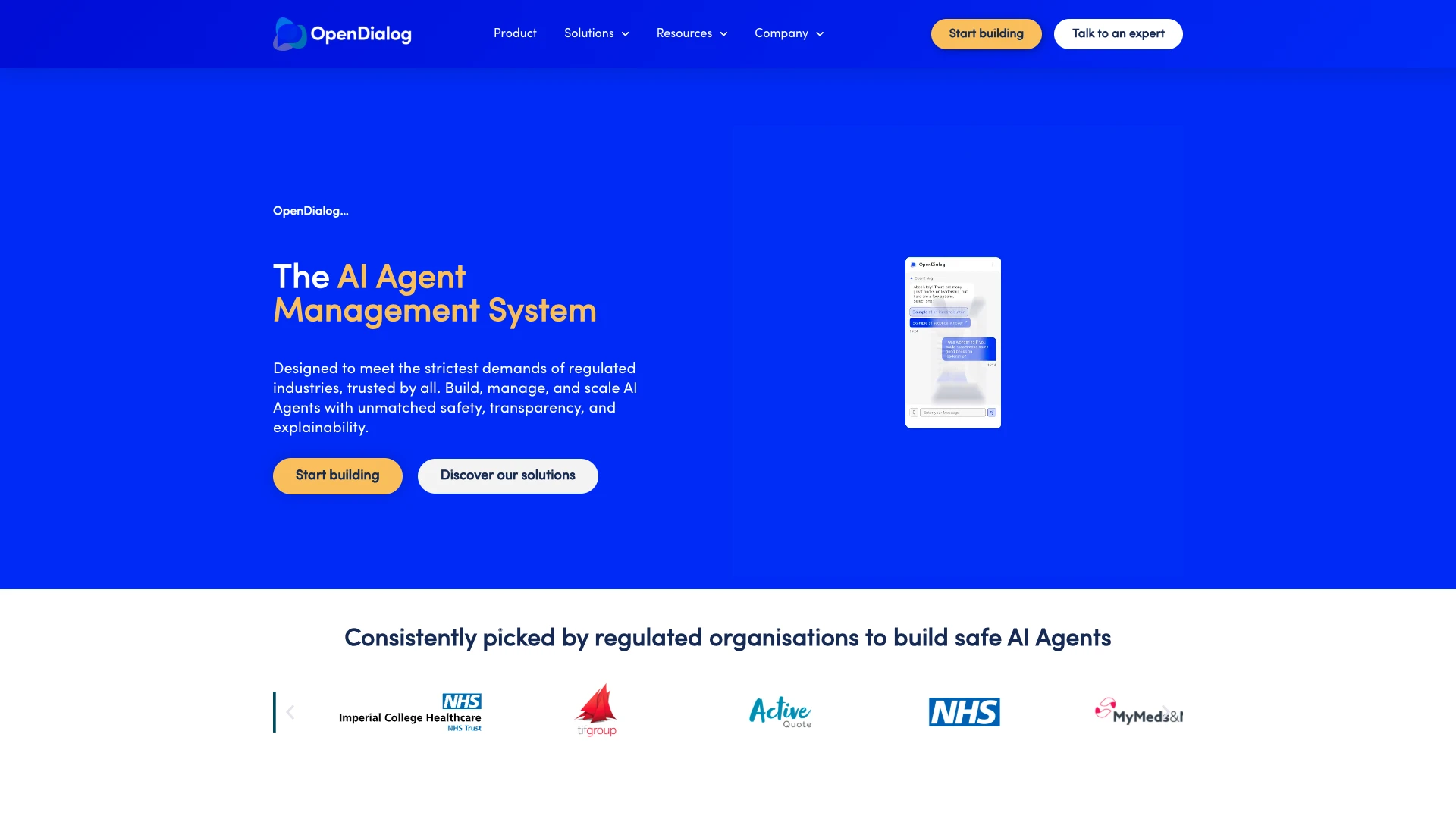
(OpenDialog Website)
Pros
OpenDialog centers around no-code, visual experiences for creating agents, chatbots, and other LLM-driven solutions. It’s particularly strong on empowering teams to create solutions for sensitive industries, such as finance and healthcare.
Helpfully, it offers live previews of agents, as well as a connectivity for third-party tools via webhooks, making it a great choice for less technical colleagues.
OpenDialog is also particularly strong on auditability and compliance features, including explainable decision making, helping to make it a great fit for outputting agentic solutions in heavily regulated industries.
Cons
As OpenDialog is more focused on the no-code side of the AI agents market, some users may find that it lacks the flexibility required for some more advanced uses, although we can also perform certain actions via their SDK.
Out-of-the-box solutions are closely aligned with a relatively small number of use cases, including finance, insurance, and healthcare. So, we might want to look elsewhere if we need domain specificity for a different function.
Some users also report performance issues when working at scale.
Pricing
OpenDialog offers a transparent pricing model, with several fixed license tiers, as well as a free license offering a single test agent.
Paid plans start at $65 per month for a single active agent, with 50,000 steps, 100MB of memory storage, and unlimited LLM tokens. Licenses to build multiple agents start from $325 per month.
Customer enterprise licenses offer unlimited usage, 1TB of memory storage, SSO, and more.
You might also like our guide to enterprise chatbots .
Turn data into action with Budibase
Budibase is the open-source, low-code platform that empowers IT teams to turn data into action.
We offer extensive connectivity for LLMs, RDBMSs, NoSQL tools, APIs, and more, alongside our autogenerated UIs, visual automation builder, optional self-hosting, and free SSO.
Take a look at our features overview to learn more.